

Testing DJI Avata: the people’s FPV drone
The Avata is DJI’s new FPV drone. It’s small, light and easy to fly. The image quality is good, but not perfect. Find out all about the Avata’s strengths and weaknesses in this review.
I’m standing on a terrace in the Verzasca Valley, with the latest electronic insect from Chinese manufacturer DJI in front of me. It’s a first-person view, or FPV, drone for short, only usable with custom flying goggles. They allow you to see what the drone sees. The goggles are mounted, I’m holding the joystick-like motion controller. Next to me is Jonas, my spotter, who will keep visual contact with the drone.
Tutorial? Haven’t done one. Manual? Unread. On purpose. After all, I also want to test the beginner friendliness and ease of use. Besides, I’m under pressure. My report has to be online in 24 hours. Admittedly, I could just be glossing over my own lack of effort– maybe I’m just too lazy. Lift off.
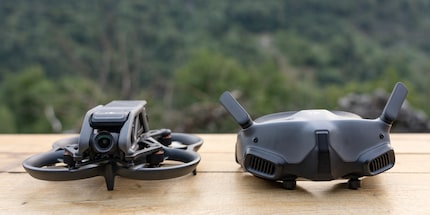
Specifications: size isn’t everything?
DJI Avata is the second FPV drone from the Chinese manufacturer. The old DJI FPV remains in our range. The Avata cannot be classified below or above it – it’s just different: at 1/1.7 inches, the sensor is larger than that of FPV (1/2.3 inches), but smaller than the sensors of regular drones such as Mini 3 Pro (1/1.3 inches), Air 2S (1 inch) or Mavic 3 Pro (4/3 inches).
In addition, the Avata is almost half the weight of its big sister and offers a slightly better video bitrate of 150 Mbps. That being said, it can’t fly quite as fast as the FPV, although the nearly 100 km/h in manual mode should still be enough for most. What’s disappointing is the weak (European) signal range of 2 km compared to the FPV’s 6 km. Here’s all the specs at a glance:
| DJI Avata | DJI FPV | |
| Size, weight | 18x8x18 cm
410 g (battery included) | 25.5×31.2×12.7 cm
795 g (battery included) |
| Battery, battery life | 35.7 Wh
18 minutes | 44.4 Wh
20 minutes |
| Top speeds | 28.8 km/h (Normal mode)
50.4 km/h (Sport mode) 97.2 km/h (Manual mode) | 54 km/h (Normal mode)
97.2 km/h (Sport mode) 140.4 km/h (Manual mode) |
| Signal range | 2 km | 6 km |
| Sensor | 1/1.7-inch CMOS sensor
48 Megapixels | 1/2.3-inch CMOS sensor
12 Megapixels |
| Lens | 155 degree FoV
12.6 mm full-frame equivalence f/2.8 fixed aperture | 150 degree FoV
14.66 mm full-frame equivalence |
| Image resolution | 4000 x 3000 Pixels | 3840 × 2160 Pixels |
| Video resolution | 4K UHD with up to 60 FPS
2.7K with up to 100 FPS (using DJI Goggles 2) 2.7K with up to 120 FPS (using DJI FPV Goggles V2) | 4K UHD with up to 60 FPS
1080p with up to 120 FPS |
| Codecs, Bitrate | H.264 and H.265
Up to 150 Mbps | H.264 and H.265
Up to 120 Mbps |
| Internal memory | 20 GB | - |
Prices and bundles
You can buy the Avata separately or in two different bundles: The «Fly Smart Combo» consists of the drone, motion controller and the V2 FPV Goggles already known from the DJI FPV. You can only get the new Goggles 2 as a «Pro-View Combo» for 300 francs more. DJI’s naming scheme causes more confusion than clarity.
Their products aren’t bargains, but aren’t completely overpriced either. The Avata, with its larger sensor, is a better buy for most hobby pilots than the older FPV, which is almost the same price in a comparable bundle. Unlike classic drones, Avata bundles bring less to the table: only one battery, no case or other accessories. Not even the mandatory USB-C charger is included. If you want the new goggles, two extra batteries, a memory card and a bag, you should budget a total of 2000 francs.
Controls: easy to learn, hard to master
Back to my maiden voyage: despite my lack of practice and general awareness, I grasp the controls of the Avata surprisingly quickly. This doesn’t speak for my talents, but for how intuitive operation is: the motion controller has a gyro sensor that registers whether and in which direction I tilt the controller. This way, using what I see in my Goggles, I control where the drone looks. As soon as I press the big button with my index finger, the Avata flies straight forward. In «Normal» and «Sport» mode, I’m so comfortable so quickly that after a short time I fluidly cover the few hundred metres to the reservoir and back again.
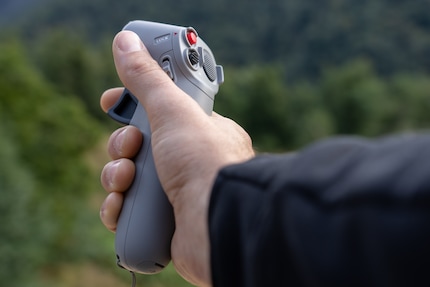
You need more practice if you want to fly and control the tilt of the camera at the same time. Flying close to trees or other objects needs to be practised well too, distances are difficult to estimate in the beginning. I didn’t try Manual mode. That only works with the normal remote controller. Without it, I reach a maximum of 50 kilometres per hour, but that feels fast enough to me – and really fun.
The low transmission range is less fun. As soon as I make a turn a little further away behind some trees, the image signal from my goggles starts to break. Strictly speaking, this shouldn’t be a problem, as you’re only allowed to fly FPV drones within visual range and with additional supervision of a second person. But especially as a beginner, I sometimes lose my sense of distance when flying and find myself behind an obstacle – the fact that the image immediately starts to flicker in such a case isn’t exactly reassuring.
Design: solid workmanship, featuring loud buzzing
The first thing you notice when unboxing: the Avata is small and lightweight. At 18 centimetres wide, it’s about as big as my hand. The propellers as well as the gimbal are protected by fixed plastic frames that look sturdy. Thus, the drone should survive the one or other flirtation with trees unharmed. The downside to this design: in a crash, the frame can potentially take damage, as opposed to an easily replaceable propeller. Collisions can easily happen. The Avata only has collision sensors at the bottom – at the front, you’ve only got yourself.
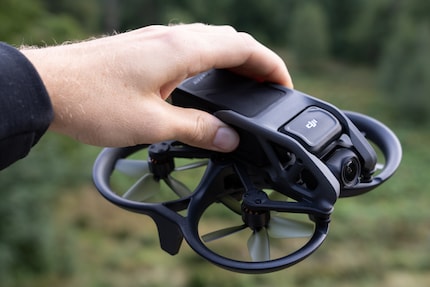
The Avata can’t be folded. Still, along with the new Goggles and Motion Controller, it’s the first truly transportable FPV drone with a decent camera. I also have nothing to criticise about the workmanship, which appears high-quality and well thought-out. I provoke a few collisions with trees and smaller plants during my tests. The result: green scratch marks, but no damage. After a restart, the Avata continues to fly as if nothing had happened.
What struck me in a bad way was the volume. I’m used to near-silence from DJI’s normal drones. The Avata buzzes loudly and at a high frequency, like an aggressive insect. Accessing the memory card is troublesome. The flap is hidden behind one of the propellers, which is constantly in the way. You therefore need a lot of dexterity to thread a small micro SD in and out. On the other hand, the Avata has 20 GB of internal memory, which is handy if you forget your card at home.
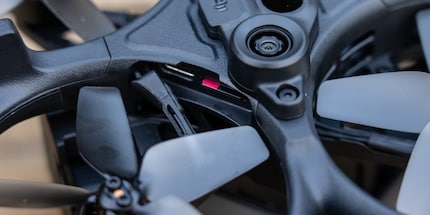
Image quality: good videos, but no miracles
The Avata’s photos can be compared with current smartphones in terms of quality. In good lighting conditions, they’re sharp and vivid. However, artefacts and also some noise are clearly visible in the 100 per cent view. With higher ISO values, the quality decreases rapidly, which is to be expected with the sensor size. I search in vain for a RAW image format or different colour profiles. All in all, the image quality is sufficient for use on social media.
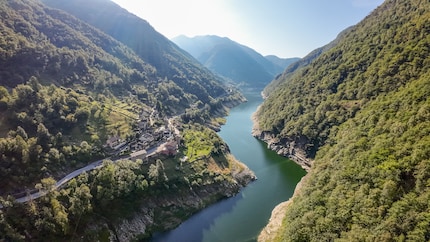
Video quality is much more important, as this is what must set the Avata apart from other FPVs. And after all, skilful flight manoeuvres only come into their own in videos at all. The movie files are actually pretty good in my initial tests. They seem detailed and are also quiet and smooth thanks to digital image stabilisation. Minus points for me are the oversaturated colours in the standard colour profile and the limited dynamic range. Furthermore, the videos look over-sharpened. This look is popular with many. Some relief is provided by the only other selectable colour profile, D-Cinelike. This works with a flatter tone curve and less saturation. In the following video, you can see two short clips in good and in poor lighting, both in the standard profile and completely unedited:
As soon as I brighten or grade the videos a bit more aggressively in DaVinci Resolve, artefacts and noise appear. The same is true in twilight, where fine forest structures become muddy. This is where the limitations of the small sensor become apparent. For a drone of this size that has to manage the balancing act between FPV capabilities and image quality, I still find the overall performance impressive.
New Goggles: a plus if you wear glasses
The new Goggles 2 are a step up from the old FPV Goggles V2. They’re much more compact, and the resolution has increased from 1440×810 to 1920×1080 pixels per eye. The battery is still an external powerbank that has to be connected with a cable – a pity, there are certainly more elegant solutions for that. What also hasn’t improved is image blurriness towards the corners. This sometimes makes it difficult to navigate menus or read parameters displayed at the edge of the screen. Fortunately, this blur is hardly noticeable when flying, since your focus is on the centre of the image. Operation is now via a touch panel on the right side. This is fiddly, but works okay with a little practice.
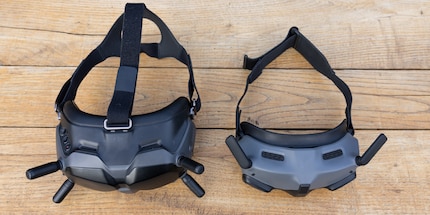
The most important new feature of the Goggles 2 for me, a wearer of glasses, is the new dioptre setting, which ranges from +2 to -8. While the old Goggles required additional inserts or contact lenses, here I can adjust the corrections for the left and right lenses separately with two wheels. This feature alone would be reason enough for me to pay the extra price for the new version – even if I have to grope for my glasses like a mole every time after taking off the goggles without contact lenses. If you have good eyes, the 300-franc upgrade is less compelling.
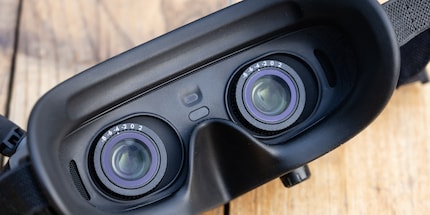
Battery life: better buy three
During my test flights, the battery does about what it promises. With my mix of flying, filming and photographing, it drops into the red zone after about 15 minutes. That’s neat, considering the flight performance. You shouldn’t expect runtimes of almost 30 minutes, as I know from my own Mavic Air 2.
Good compatibility with the old FPV
Good news for those who already have a DJI FPV and want the Avata as a secondary drone. Both the controllers and Goggles are compatible, which lowers the purchase price. By the way, this also works the other way around – the new Goggles 2 are also compatible with both drones. I think it’s commendable that DJI allows this compatibility in both directions.
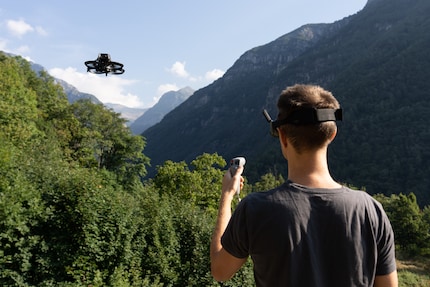
Verdict: not perfect, but a good compromise
My opinion after 24 hours with the DJI Avata: it’s tremendously fun, easy to fly, and the video quality is impressive. It is, for me, the first truly mass-market FPV drone as it actually fits nicely in a backpack along with the new Goggles. Additional points go to the protected propellers, which let me try risky manoeuvres with more confidence.
Flying with the goggles still takes some getting used to and I don’t find the touch operation of the Goggles optimal. However, its biggest weakness for me is the low transmission range. Add to that the steep price – especially since you realistically need at least two extra batteries. Still, the DJI Avata is the best FPV combination of image quality, flight feel and compactness yet.
My fingerprint often changes so drastically that my MacBook doesn't recognise it anymore. The reason? If I'm not clinging to a monitor or camera, I'm probably clinging to a rockface by the tips of my fingers.




